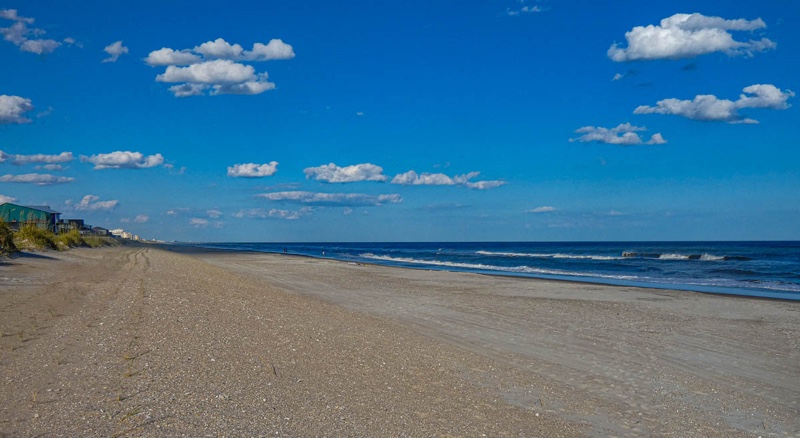New Beaches for the Fourth

If you are a new visitor to the Crystal Coast, which stretches from the Swansboro, North Carolina, area to the Down East part of Carteret County, you might not notice the difference in the sand when you walk on the beach near the surf. Many residents or frequent visitors will notice that there is a lot less soft white sand and a lot more heavy red sand. They might also pick the new line of grasses planted to stabilize the sand and build a new dune.
The reason of course is Hurricane Florence which changed many of the beaches. I walked on several of the area beaches just after Florence and I thought the damage was minimal. It turns out that some the beaches most impacted were ones that are out of the path of my normal hikes.
My first post-Florence walk along the beaches at the Point showed some damage but not a lot of reshaping. Later as I visited Third Street and talked to others, I learned that some areas lost most of their protective dunes.
In an area where the beach is the economy, damage to the dunes means a beach renourishment project. You can read all about the most recent project and see pictures at this Carteret County website.
Aside from less soft sand and some steeper beach drop offs, I have heard very little discussion on the beach renourishment project. There was certainly no debate about it here.
While the project is undoubtedly needed to protect the tourist business, it does come with some negatives. In fact some sites do not call it beach renourishment, they call it beach fill which seems closer to the truth.
When they do a beach fill/renourishment project, you are pumping very different sand sometimes from a considerable distance off the beach onto the shoreline. The new sand, bulldozing and reshaping does disturb/kill some of the creatures whose home is on the beach. I cannot speak to exactly what this most recent fill project has done to the health of the beaches. In my world which includes the marshes and big rivers like the White Oak, Florence changed many things and lots of them were far from the beach. While our homes might not have been damaged, we are still dealing with the impacts from Hurricane Florence. I cannot even drive the ten minutes to the beach from my house without being reminded of the homes and businesses lost and we were a relatively lucky area. Carteret County schools were closed for two weeks. In our neighboring county to the south, Onslow County, schools were closed for two months.
In an area such as ours which is heavily dependent on tourist the scales might favor beach renourishment/fill but they does not negate the fact that it might well be a losing battle. Building houses on barrier islands has always been building on shifting sands. The natural process has always meant that some places are the beneficiary of the moving sands and others will lose what sand they might have just gotten.
We sometimes joke that Carteret County could use a little sea level rise. To those of us who are boaters, the area waters are a lot of water spread mighty thin. The reality of our future might be much different.
We are lucky to have well-treed, strong barrier islands and plenty of marshes with healthy marsh grasses. Other areas were much less fortunate than the Crystal Coast during Florence. Whether they will be enough the next time or not, we will count our blessings and be thankful for the sand that we have whether it is new or old.
Most of us understand that the beaches will never stay the same. The next Florence might make new inlet as has happened during some storms on the Northern Outer Banks.
What we can do over time is too understand the tradeoffs that we face in keeping the tourist trade going and beach front home owners in their houses. It is not as simple as it might seem. The lack of soft sand in places is likely the least of our worries.
Click to go back to the Crystal Coast Life blog or back to the Crystal Coast Life homepage.